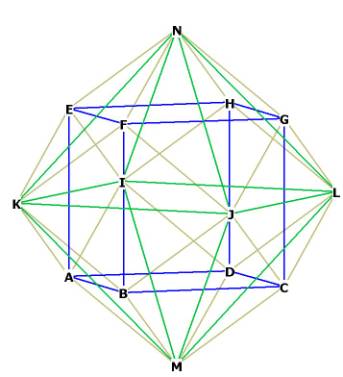|
(2017
midterm assignment) Model Student Midterm answers 2016 (Index) Essay 3: Web Highlights |
 |
Clark Omo
Highlighting the Highlights: Narratives Explored in Literature of the
Future
In
his essay, “A
Phoenix Must First Burn: Analyzing Decline in Future Narratives”, Timothy Morrow
examines the Creation/Apocalypse narrative prevalent in Literature of the Future
and then intertwines said narrative throughout several works thus studied so far
in this class, including Octavia Butler’s
The Parable of the Sower, the short story “Stone Lives”, and H.G. Wells’s
The Time Machine. Morrow begins by
identifying these narratives as a pattern; one which the authors must abide by.
The first of these patterns he examines is that of the Apocalypse/Creation
narrative, where a world is first created with a sort of Edenic state of being
at its initial onset and then, gradually, worsens throughout the course of the
story to a point of complete destruction and utter deprivation. Morrow uses
Parable of the Sower to demonstrate
this; for, as Morrow aptly identifies, the story by Butler follows much in line
with the narrative of the Book of Genesis to Revelation. Like these two books of
the Bible, Parable of the Sower
begins with characters residing in an Eden-like environment, only for it to be
taken from her as the “the
apocalyptic world shatters her protection” as Morrow puts it. Furthermore,
Morrow goes on to examine the correlation between the Evolution narrative and
that of “Stone Lives”, as well as The
Time Machine and The Parable of the
Sower. He intertwines the ideas of man evolving, but not necessarily for
benefit, in “Stone Lives”, a tale of a man without sight who manages to escape a
futuristic world likened to the animal kingdom with its cruelty and savagery.
This granted a technological advantage that essentially makes him the “top dog”
and then discovers his world is even more corrupt than at first thought. Morrow
applies this idea to The Time Machine
as well, where he illustrates that the world the Time Traveler visits “is not
one falling into destruction from decline, but through advancement”. Morrow
labels this story, whose beginning is initiated by the Creation of a flawless
state of being which then eventually reaches its terminus with the Apocalypse,
the Narrative of Decline.
Overall, I found Morrow’s examination of the Creation/Apocalypse narrative
well-constructed and insightful. He connects the narrative well to the stories
he chose (The Parable of the Sower,
The Time Machine, and “Stone Lives”),
and he excellently explains how the narrative functions within these stories.
The most surprising, and indeed, informative, aspect within Morrow’s essay is
his examination of the Romance Narrative present within the stories selected. I
very much agree with this analysis; each of the stories show some evidence of
the tropes characteristic of Romance. “Stone Lives” is a surefire example, and
Morrow’s description of the titular protagonist Stone escaping his
“antagonistic” environment to become the “top dog” epitomizes the standard
Romance plot. It is interesting to note that science fiction has chosen to
choose this same narrative structure to tell its stories. To me, this proves
that the objectives of Speculative Fiction are not considerably separated from
that of Romantic Literature. Science Fiction focuses on escaping to an alternate
timeline, a future fate, or even through biological (or technological)
advancement through an evolutionary cycle in which man can somehow escape his
own limitations and achieve some sort of ultimate ascendancy over a corrupt and
constraining environment. And Literature of the Future places the solution to
this escape in the hands of the Apocalypse and Evolution.
The concepts of the Creation/Apocalyptic and the Evolution narrative are also
explored by Tom Britt in his essay, “A Gift to the Dead and a Warning to the
Living”. Britt also connects the Creation/Apocalypse narrative to
The Parable of the Sower, much like
Morrow did. As Britt explains “that it is possible for texts to not focus solely
on an apocalyptic / creation narrative, but also have the capability of weaving
evolutionary themes in, as well.” Britt identifies that two narratives
characteristic of Literature of the Future can be interwoven into a single story
simultaneously. This conclusion means that stories whose plots and settings
involve futures of decline and destruction often tend to have the
Creation/Apocalyptic Narrative and the Evolution Narrative walk side by side.
They both seem to say something, maybe not in the same words per se, concomitant
regarding the future of mankind. Britt goes further regarding
The Parable of the Sower, saying that
Lauren’s (the protagonist of the story) creation of her “God is change” mantra
reinforces the narrative of “cyclical creation and destruction.” Britt’s
analysis is well informed as well as in compliance with the themes so far
explored in class.
That being said, I must say I found Britt’s essay helpful, as well as in
agreement, to my own perceptions regarding Literature of the Future. As Morrow
examined, the tales and adventures in Literature of the Future are redolent with
the Romantic aromas of escapism, sublimity, and ascendance. The protagonists
(i.e. Stone and Lauren) are classic apexes of the Romantic hero trying to escape
his/her surroundings in order to find a much more pleasing existence. Britt goes
along with this idea of coexisting narratives within the same narrative body,
for he states that both the Evolutionary and Creation/Apocalypse dwell within
the same story: The Parable of the Sower.
It is worthy of note that both Britt and Morrow are able to see more than one
sort of narration at work within a story; thus affirming that stories rarely if
ever follow a single type of story trope, but rather can contain elements of
many. This is an idea concomitant to my own. I have seen elements of many
narratives laced within the pages of one story. Thus, I agree with both Britt’s
and Morrow’s analyses of the story’s they chose, and I now have reinforcement
for my own perceptions as I begin to study my own selected pieces from the class
itinerary provided so far.
In connection with Britt and Morrow, Zach Thomas also analyses the
Creation/Apocalyptic and Evolutionary Narratives in his essay, “Where is Our
Humanity?” He begins by analyzing the presence of the Creation/Apocalyptic
Narrative in its great forerunner, the Book of Revelation. Thomas states that
“God will use this fire [the judgement described in Revelation] to purify the
present world we live in, in order to create a new heavens and a new Earth” From
here, Thomas, interestingly and perhaps boldly, decides to label this story
evolutionary, stating the present decaying state of the earth will disintegrate
and then transform into the “picture
of the future as the Earth is evolving into what God intended it to be.” Like
Morrow and Britt, Thomas has identified an additional narrative underlying that
of the Creation/Apocalypse Narrative with Revelation: a bold move. Thomas then
expands and connects this narrative to the short story, “Bears Discover Fire”.
In this analysis, Thomas identifies a different set of anxieties present within
the narrative of “Bears Discover Fire” regarding reactions to the bears
discovering fire. Thomas states that for the most part, people react negatively
to this sudden and unforeseen occurrence of bears suddenly gaining the
intelligence necessary to put sticks in a pile and then set them alight to
create a flame. He contrasts this general reaction to that of the grandmother,
who seems to be, as Thomas concludes, “The grandmother simply left her
retirement home and found refuge with the bears.” Thomas provides an interesting
perspective on this narrative, and his statement of the Bible containing an
evolutionary undertone is most intriguing.
Overall, I would say that Thomas’s analysis of the Evolutionary narrative is
well applied. As Morrow and Britt before him, Thomas manages to apply the
Evolutionary Narrative to his selected pieces of Literature well. In addition to
this, Thomas also touched upon a critical point that I myself will be examining
in my essay: the point of the narratives present with Literature of the Future
and how they relate the anxieties shared by most human beings regarding the
possible outcomes of our actions in the present. Thomas approaches this subject
through the grandmother in “Bears Discover Fire”; the grandmother’s reaction, in
opposite to that of the world around her, is one of gentle acceptance of the
fact the bears are simply reaching a natural point in their evolutionary lives.
I plan to explore such reactions in my own essay, and it is reassuring to find
another student with the same notions at least present in his own mind.
Another essay worthy of review is Morrow’s research essay, “All
Lilies Wither: Analyzing Violence towards Women in Science Fiction”. While
slightly discordant with the themes so far explored in this review piece,
Morrow’s essay is nonetheless critical to understanding Literature of the Future
and its limitations. Morrow’s essay examines the treatment of women in
Literature of the Future, i.e. their subjected status as well as abuse. I agree
with his statement that women have traditionally taken a hyper-sexual role
within the stories often consigned to the Science Fiction genre. Indeed, comic
books, whose majority of stories are nothing
but Science Fiction, portray women
with nothing but hyper-sexualized imagery: smooth and perfect skin, engorged
breasts, flawless complexions, and trim waistlines. This being said, it seems
that Literature of the Future, along with many other budding genres outside the
literary canon, is at risk of falling into popular tropes in order to appease
and satisfy audiences, rather than exploring relevant issues pivotal to our
society. This seems detrimental and counterintuitive, considering the potential
that this genre has for exploration of ideals beyond those that are meant only
to sell the merchandise. Morrow does well at identifying this trope, for not
only does this render women to a cliché and uninteresting status as characters,
but also alienates the audience to a certain level. Finding gorgeous women in
such circumstances (i.e. “Stone Lives”) is utterly remote and unrealistic.
Morrow’s identification of such tropes within science fiction attests to the
fact that it still has a long way to come to be considered as a body of
literature worthy of study.
 |
 |
 |
